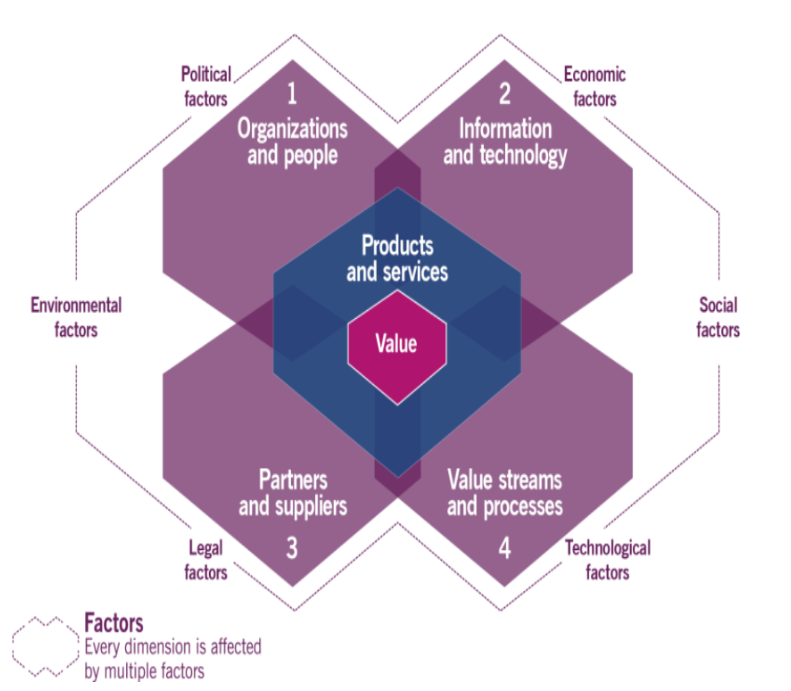To provide a comprehensive approach to service management, ITIL identifies 4 Core Dimensions that work together to efficiently deliver value to customers and other stakeholders through Products and Services.
These four Dimensions offer crucial perspectives on the entire Service Value System (SVS), which includes the entire Service Value Chain (SVC) and all ITIL Practices.
The 4 Dimensions of Service Management Model
To ensure a holistic approach to service management, ITIL outlines four dimensions, which must be taken into account by each component of the SVS.
The four dimensions are:
- Organisations and people
- Information and technology
- Partners and suppliers
- Value streams and processes

By giving each of the four dimensions the right level of attention, an organisation ensures that its Service Value System will remain balanced and effective.
Although the 4 dimensions have no clear boundaries and may overlap, all components of the SVS are applicable to these 4 dimensions.
1. Organisations and people
This dimension concerns the corporate organisation and its culture. It includes the requirement to develop competencies appropriate to the needs and to create a working environment that supports the management of IT services.
The organisational environment is becoming increasingly complex, so it is crucial to ensure that the structure, management, roles, responsibilities and authority and communication systems are clearly defined and support the company’s strategy and operating model. This includes:
- Definition of roles and responsibilities
- Formal organisations
- Management and leadership approaches
- Crossing boundaries between departments
- Definition of a corporate culture
- Development of skills and recruitment necessary for the creation, delivery and improvement of services
It is all about the design, delivery and optimisation of a service.
As far as culture is concerned, it is crucial that the organisation’s leaders promote values that inspire people to work cohesively, promoting:
- Shared values and behaviours
- Trust and transparency
- Communication and collaboration skills
2. Information and technology
When considered within the Service Value System (SVS), the Information and Technology Dimension encompasses the information and knowledge needed to manage services, together with the required technologies. It also integrates the relationships between the various components of the SVS, such as the inputs and outputs of activities and practices.
This dimension is in turn divided into:
1. Technology supporting Service Management which includes:
- Workflow Management
- Inventory systems
- Knowledge bases
- Artificial intelligence
- Communication systems
- Mobile platforms
- Remote collaboration
- Cloud solutions
- Analytical tools
- Machine learning
2. Technology supporting IT services including:
- IT architecture
- Applications
- Databases
- Communication systems
- Blockchain
- Artificial Intelligence
- Cloud
- Cognitive computing
- Mobile applications
Another important consideration is how information is exchanged between different service components. It is essential to fully understand the information architecture and to optimise it continuously. Information optimisation criteria include:
- Availability
- Relevance
- Accuracy
- Timeliness
- Accessibility
- Reliability
Information management challenges, such as regulatory compliance and security requirements, are also at the heart of this Dimension (e.g. GDPR…).
For example, some of the questions a customer might ask are:
- Is this technology compatible with the current architecture of the organisation and its customers?
- Does the organisation have the necessary skills to support it?
- Does it comply with corporate information security regulations and policies?
- Does it have automatic functionalities for effective development and implementation? Will it be usable in the future?
- Does it offer benefits for other products and services?
- Is it aligned with vendor and customer strategies?
- Does it introduce new risks?
All of these questions show that a prevailing mindset within an organisation could greatly influence the selection of technologies adopted. In addition, the industry of the company can also influence technology choices.
3. Partners and suppliers
The Partners and Suppliers Dimension covers a company’s relationship with other organisations involved in the design, development, delivery, support and continuous improvement of services. This also includes contracts and agreements between the organisation and its partners and suppliers. Service integration and management can be handled internally or delegated to a trusted partner, known as a service integrator, to ensure proper coordination of service relationships.
Organisational relationships relate to each other in various aspects: types of cooperation, service partnerships and supply of goods.
Various factors can influence an organisation’s strategy in selecting suppliers:
- Strategic focus
- External constraints
- External experience
- Demand trajectories
- Cost-related criticality
- Scarcity of resources
- Corporate culture
4. Value streams and processes
The last of the four dimensions, Value Streams and Processes, focuses on the organisation and its Service Value System (SVS), particularly on the integration and coordination of the various parts of the organisation to ensure value creation through Products and Services.
What is meant by value stream and process:
- A value stream is a series of steps that an organisation follows to create and deliver Products and Services to a Service Consumer. A value stream is a combination of the Service Value Chain (SVC) activities in an organisation.
- A process is a coordinated set of activities that transforms inputs into outputs. Processes take defined inputs and transform them into defined outputs by establishing the sequence of activities and their interconnections. They outline what needs to be done to achieve a goal and, if well defined, can improve productivity within and between organisations. They are usually detailed in procedures, which specify who is involved, and in operating instructions, which explain how to carry out these procedures.
The value stream is an important reference point to:
- Improve the organisation’s overall performance
- Provide a clear view of what is being delivered and how it is being delivered
- Examine the current state and identify any obstacles in the workflow, as well as activities that do not add value (as described in the Lean IT methodology)
Value streams and processes are in many ways similar, but should not be confused as they have different perspectives and objectives.
Optimising the value stream may involve automating processes, adopting emerging technologies or implementing new working approaches to increase efficiency or improve the user experience.
The latter dimension focuses on the organisation and on the efficiency of its activities to ensure value creation for all parties involved. ITIL provides an operational model, the Service Value Chain (SVC), which includes the activities essential to manage products and services. Although the SVC is generic, it can follow different paths, known as value streams.
PESTLE Analysis: The 6 External Factors that Influence the 4 Dimensions
PESTLE is defined as the model that describes the 6 external factors that can impact and influence the way organisations shape their resources.
PESTLE analysis is a strategic tool for companies, enabling them to assess the current and future impact of various elements on their operations. This tool helps organisations identify, assess, organise and monitor the macroeconomic factors that influence business performance. These factors may be political, economic, social, technological, legal or environmental in nature.
PESTLE analyses are critical because they provide information for strategic planning, budget allocation and market research strategies.
PESTLE is an acronym whose letters indicate the factors that the organisation must take into account:
P : Political
E : Economic
S : Social
T : Technological
L : Legal
E : Environmental
An organisation is not an isolated system, but rather an open system that interacts closely with its surroundings. Therefore, when it has to make decisions whose consequences are influenced by external, uncontrollable factors, it is essential to have a clear view of what is happening externally. In particular, it is essential to understand how these external factors may influence product launches, project start-ups or investment decisions.
If you are interested in learning more about how the ITIL Service Value Chain can help you advance in your professional development, read our blog “Service Value Chain and Value Stream”.
QRP International is an ATO (Authorised Training Organisation) for ITIL. Have a look at our ITIL Courses or contact us if you have any questions!









